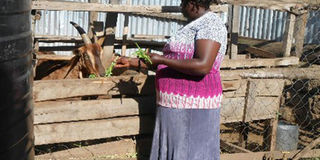What you can do with your rocky, quarter acre

Betty Kipyegon, a farmer in Kabarnet, Baringo County. PHOTO|GLORIA MWANIGA|NATION
What you need to know:
- Hezekiah Korir, a soil scientist from the Crops, Horticulture and Soils Department, Egerton University, says that to rehabilitate a rocky land, a farmer can start by removing the small rocks and then planting drought-tolerant crops like millet or fruit crops whose roots will help loosen the rocks.
- To maximise the use of a small land, Korir advises farmers to partition the farm and grow a variety of crops on each portion. Also, he says that the crops grown should have a short maturity period to increase the number of harvests.
- Korir further advises farmers to add manure to such land.
There is a winded road that runs from Nakuru town to the round, topped Tugen hills.
These hills are grass covered and full of goats that roam freely, sometimes forcing drivers on the route to break sharply to avoid hitting them.
Just a kilometre before Kabarnet town, where the road shoulders to the right, there’s a little centre called Kasoyo where Betty Kipyegon calls home
Her 100 by 100 feet piece of land where she stays with her family lies on a rocky terrain well-known to Kabarnet dwellers.
As one gets in through the blue gate, the compound, half of which is covered by a huge stone family house, looks rather small. In fact, it is almost impossible to believe that there is so much agriculture going on here.
Land transformation
The patch in front of her house is full of huge, healthy collard green and spinach vegetables, which Betty says she sells to her neighbours. So, how did she transform the rocky land into productive land?
“We cleared the rocks then dug deep to get the soil. Afterwards, we mixed fresh cow dung, goat and chicken droppings to make the soil fertile.”
Her efforts have borne fruit as she currently has healthy vegetables, which give her a net income of Sh6,000 every month.
Hezekiah Korir, a soil scientist from the Crops, Horticulture and Soils Department, Egerton University, says that to rehabilitate a rocky land, a farmer can start by removing the small rocks and then planting drought-tolerant crops like millet or fruit crops whose roots will help loosen the rocks.
Korir further advises farmers to add manure to such land. “With time, as a farmer weeds the crops, more rocks will be removed and the deep set rocks will become loose thus easy to remove.’’
Secrets to quality breeds
Further inside the compound, there is a goat pen where two she-goats and five kids are nibbling away at greens. “There is no wastage here. We feed the goats on vegetables, potato, fruit and bean waste. In return, the animals provide excellent manure,” says Betty.
Her doe has been a champion at the Kabarnet ASK show for three years running, making its kids most-sought after.
“We sell the billy goats at Sh7,000 and the does at Sh15,000 minimum price, and they give birth twice a year,” says Betty’s husband, Silverno Cheptarus, pointing at the pure Alpine breed animals.
The secret to quality goats, according to Betty, is to avoid inbreeding. “We really avoid inbreeding. Five months after they are born, we separate the male kids from their mother.”
“Also, even though the doe is ready to be served five months after it is born, we wait until it is at least a year-old before we let it get served. This helps them grow really big,” says Betty, adding they get three litres of milk a day.
They, however, sell the milk they get from their two cows, a Friesian and an Ayrshire, with the zero-grazing unit still hosted in the 100 by 100 feet land.
“I milk them at 6am after I have seen my children off to school,” says the mother of three, who supplies 45 litres of milk at Sh50 per litre to a local dairy plant daily.
Their enterprise does not end there. Just past the cow pen, there is a chicken coop where the couple keeps their 70 Kenbrow chickens, which offer them about two trays of eggs a day that sell at Sh450 each. The birds go for Sh1,000 each.
To maximise the use of a small land, Korir advises farmers to partition the farm and grow a variety of crops on each portion. Also, he says that the crops grown should have a short maturity period to increase the number of harvests.
The couple cite high cost of commercial feeds and difficulties in getting green feeds due to the urban setting as some of the challenges they face with their livestock.
“But we make our animal feeds by mixing maize germ, oats, hay, wheat bran and molasses for the cows. We buy the maize germ, bran and molasses but get the oats and hay from our other farm in Nakuru,” says Cheptarus, who is the ASK Kabarnet branch chairman and a secondary school principal.





